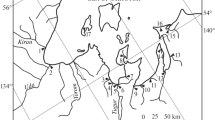Conclusions
-
1.
The downstream regimen of freezing and the volume of the river flow exert a decisive effect on the magnitude of the backwater due to ice, ΔH3. For a given length of the unfrozen patch, the quantity ΔH3 is directly proportional to the duration of the ice-drift period downstream, and to the magnitude of the discharges through the plant during that period.
-
2.
The sharp increase of discharges through the plant, after Sundays, at the beginning of the winter period, as the ice edge approaches the plant, in combination with an unstable regimen of the air temperatures, results in artificial ice drift, ice jams, higher roughness coefficients of the lower surface of the ice, and higher values of ΔH3.
-
3.
During the period of stabilization of the ice edge, under negative air temperatures, the nonuniformity and magnitude of the discharges through the plant do not exert an unfavorable influence on the ice regime downstream.
Similar content being viewed by others
Literature Cited
S. N. Kritskii, M. F. Menkel’, and K. I. Rossinskii, Winter Thermal Regimen of Reservoirs, Rivers, and Canals [in Russian], Gosénergoizdat (1947).
Ya. L. Gotrib, E. E. Zaimin, F. F. Razzorenov, and B. S. Tseitlin, Ice Thermostatics of the Angara [in Russian], Gidrometeoizdat (1964).
S. N. Bulatov, “Relation between the process of ice development and the winter volume of a river downstream from a hydroelectric plant,” Gidrotekh. Stroitel’., No. 2 (1958).
A. M. Estifeev, “Ice phenomena in large rivers of the USSR and their effect on the design of hydraulic developments,” Izvestiya VNIIG,78 (1965).
A. M. Estifeev, “Regulation of the flows in a cascade of hydroelectric plants as a measure for reducing the cost of construction,” AN SSSR, Sibirskoe Otdelenie, Trudy Transportno-Ékonomicheskogo Inst., Vol. XI (1961).
V. A. Rymsha and R. V. Donchenko, “Investigation and analysis of the freezing of rivers and reservoirs,” Trudy GGI, No. 129, Gidrometeoizdat (1965).
B. S. Tseitlin and I. K. Levin, “Investigation of the transitional coefficients in the downstream reaches of hydroelectric plants, on the basis of the Rybinsk hydroelectric plant,” Meteorologiya i Gidrologiya, No. 5 (1960).
I. A. Karmazin and B. Z. Vil’nits, “Analyses for establishing the optimum length of a nonfreezing deep opening downstream from the Kamsk hydroelectric plant,” in: Articles on the Exchange of Experience Relating to the Operation of Power Installations, NTO ÉP, Permskoe Pravlenie, Perm (1966).
A. T. Bogdanov, “Effect of the winter regimen of the nonstabilized downstream side of a large hydroelectric plant on its head,” VNIIG, Correspondence Conference, Paper No. 26, Rotaprint.
A. G. Deryugin, “The ice regimen of the downstream side of the Nizhme-Svirsk hydroelectric plant,” Trudy GGI, No. 103, Gidrometeoizdat (1963).
I. N. Solokov, “Improvement of the capacity of the Gor’kovsk hydroelectric plant by increasing the length of the deep opening downstream,” Trudy Koordinatsionnykh Soveshchanii po Gidrotekhnike, No. 42, Énergiya (1968).
P. N. Belokon’, Engineering Hydraulics of the Flow under an Ice Sheet [in Russian], Gosénergoizdat (1940).
Additional information
Translated from Gidrotekhnicheskoe Stroitel’stvo, No. 1, pp. 33–35, January, 1970.
Rights and permissions
About this article
Cite this article
Smelyakova, A.D. The ICE regimen of nonstabilized downstream reaches of hydraulic developments. Hydrotechnical Construction 4, 50–53 (1970). https://doi.org/10.1007/BF02376212
Issue Date:
DOI: https://doi.org/10.1007/BF02376212




